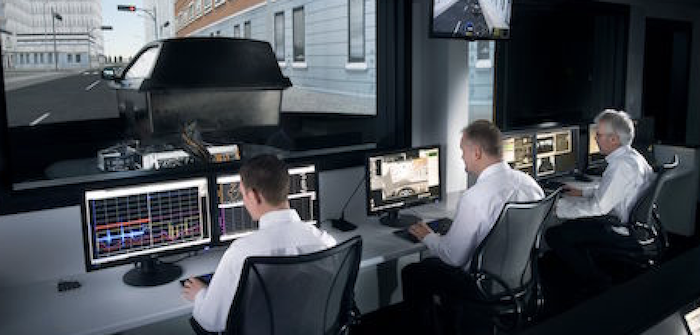The increasing adoption of advanced driver assistance systems presents a fascinating challenge for verification and testing engineers. Perhaps more so than any other aspect of a vehicle, this is where the actions of a machine and a human driver become entwined. And it means human beings are a vital part of the test and verification process for vehicles with ADAS.
Ironically, the sheer scope of this technology often means that human input is intentionally reduced in the early stages of verification. If one considers all the possible scenarios that might be presented to a collision avoidance system, for instance, it’s easy enough to conclude that it can lead to hundreds of thousands of combinations that would require scrutiny. Consequently, off-line simulation tools are required to slug through the intense number crunching that is needed to generate all the objective maps and response surfaces required to predict complex behaviors in the early development stages. While this is efficient and productive, purely objective feedback cannot inform vehicle designers about how evaluation drivers might respond to implementations.
So, as soon as objective predictions can be whittled down into a more manageable subset of scenarios it makes good sense to bring human drivers into the test program. After all, people will ultimately decide the success or failure of vehicle features and functions in the marketplace. For example, the point where functions such as ESC or AEB should intervene is highly subjective. These tend to occur in highly dynamic situations, where it’s vital to get representative inputs from a real driver to guard against behavior conflicts.
Driver-in-the-loop (DIL) testing can bring human interaction forward dramatically in a vehicle project’s timescale and can dramatically increase the frequency of driver contact with imagined systems as they are being tuned and developed. Most importantly, this means that potential issues can be identified early on, when they are less costly to address, at a time when physical prototypes might not even be available. Even when prototype vehicles are available they can often be in short supply, and potentially appropriated to other areas for other tests, so a DIL simulation program helps to manage the workload.
Of course, there are a number of other benefits to DIL testing. Chief among these is safety: drivers are free to charge headlong toward oncoming traffic or infrastructure scenarios with no more than pixels put at risk. In fact, one might argue that DIL simulation has the edge over real-world testing in many cases because every detail of the sensor inputs and scene can be scripted and repeated at will, and new ‘what if?’ scenarios are only a keystroke or two away. Things like grip levels and environmental conditions can be modified almost instantaneously or kept absolutely identical across a series of tests.
And, ironically, virtual test driving even offers some advantages in terms of realism when compared with real-world proving ground tests. Real radar signatures, for instance, can be presented to a real sensor (via HiL) and a real driver in a DIL lab, rather than relying on an inflatable obstacle or a cardboard cut-out representation.
Ultimately, though, the value of DIL lab testing hinges on being able to elicit realistic responses and behaviors from human drivers, and that’s not as easy as one might think. Experienced test drivers, who have finely-tuned senses for what real cars feel like in various conditions, are extremely sensitive when their expectations are violated. Such drivers will simply not accept DIL simulators as vehicle development tools if the feedback provided to them is inaccurate. From a DIL simulation perspective it is mission critical to deliver the correct motion cues, correct levels of graphical latency, correct tactile and auditory stimulation, and so on. Engineering DIL simulators is another topic altogether.
As technologies continue to emerge and converge, the task of verifying and testing ADAS systems will invariably become more complex for car makers. Vehicle onboard systems that were previously on the emerging technology list – such as ESC and ABS – are now mandatory in most markets. That is just the tip of the iceberg.
Lane departure warning systems and AEB are now legal requirements on all new heavy goods vehicles registered in Europe. It is thought that this is likely to extend to passenger cars and light commercials before too long (where ADAS systems already contribute to the much-publicized Euro NCAP safety ratings). Meanwhile, in the USA, the NHTSA (National Highway Traffic Safety Administration), the IIHS (Insurance Institute for Highway Safety) and most of the nation’s OEMs have announced an informal agreement to make AEB standard by 2022.
All this means that auto makers will be tackling a lot more testing and development work in order to deploy these (and other) ADAS systems. It won’t stop there either. Partial autonomy is already creeping into the car industry and this, perhaps ironically again – since driverless cars do not require ‘drivers’ per se – is another area where DIL simulators are helping the cause. With regard to the all-important handovers to and from human drivers and autonomous running modes, DIL simulators are proving to be the go-to tool. If we were to sneak a peek behind the auto industry’s R&D curtain, what might we surmise? Well, one thing is for certain – it’s certainly a busy time.
Phil Morse is technical liaison at Ansible Motion





